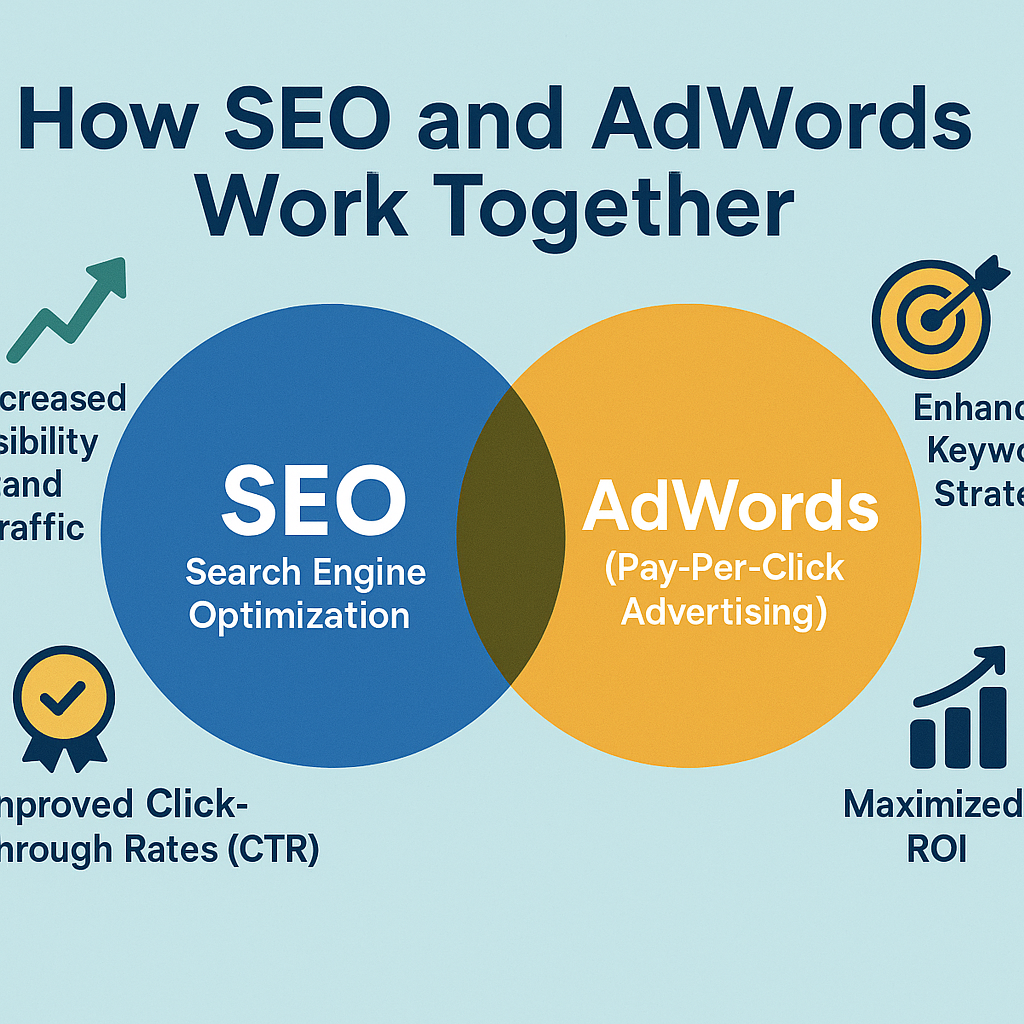When used together, SEO and AdWords create a comprehensive strategy that maximizes website visibility, drives more traffic, and retains customers even after ad campaigns conclude.
What is PPC (or SEM)?
Pay-Per-Click (PPC) and Search Engine Marketing (SEM) are key digital marketing strategies that drive traffic to websites through paid ads.
Understanding PPC (Pay-Per-Click)
PPC is an online marketing model where advertisers pay a fee each time their ad is clicked. It’s a way to buy visits to your site rather than earning them organically. The most common form of PPC is search engine advertising, where advertisers bid for ad placement in a search engine’s sponsored links when someone searches a term related to what they offer.
Key Elements of PPC
- Keywords: The foundation of PPC campaigns; advertisers bid on keywords users might enter when searching for products or services.
- Ad Copy: The text of the ad must be compelling and relevant to attract clicks.
- Landing Pages: The pages users land on after clicking the ad need to be optimized for conversion.
What is SEM (Search Engine Marketing)?
SEM includes both paid search activities (like PPC) and organic search activities (like SEO). It involves promoting websites by increasing their visibility in search engine results through optimization and paid ads.
Components of SEM
- PPC Campaigns: Paid efforts to drive traffic and visibility through search engines.
- SEO (Search Engine Optimization): Organic efforts to improve a website’s ranking through on-page and off-page optimization techniques.
Benefits of PPC and SEM
- Immediate Results: PPC can drive traffic almost instantly after the ads go live.
- Targeted Advertising: Both PPC and SEM allow for highly targeted ads based on keywords, demographics, location, etc.
- Measurable ROI: PPC provides clear metrics for measuring the success of an ad campaign.
- Enhanced Brand Visibility: SEM increases overall visibility through both paid and organic search results.
How PPC and SEM Work Together
Combining PPC and SEM strategies can maximize visibility and reach. While SEO focuses on long-term growth, PPC provides immediate results and insights that can enhance SEO efforts.
How SEO and AdWords Work Together
SEO (Search Engine Optimization) and AdWords (Pay-Per-Click advertising) are powerful tools in digital marketing. While SEO focuses on improving organic search rankings over time, AdWords provides immediate visibility through paid ads. When used together, they create a comprehensive strategy that maximizes a website’s visibility, drives more traffic, and boosts overall performance.
What is SEO?
Search Engine Optimization (SEO) improves the quality and quantity of website traffic by increasing the visibility of a website in search engine results pages (SERPs). SEO optimizes website elements and content to rank higher in organic search results.
Benefits of SEO
- Increased Visibility: Higher rankings in search results lead to more visibility.
- Targeted Traffic: Attracts visitors actively searching for relevant information, products, or services.
- Credibility and Trust: High rankings convey trust and authority to users.
- Cost-Effective: Organic traffic is essentially free after the initial investment in SEO.
- Long-Term Results: SEO benefits can last a long time, providing continuous traffic.
Benefits of Using SEO and AdWords Together
Combining SEO and AdWords can create a powerful marketing strategy with several benefits:
Increased Visibility and Traffic
- SEO: Provides organic visibility and attracts traffic through high rankings.
- AdWords: Ensures visibility by placing ads at the top of the SERPs, capturing users’ attention instantly.
Comprehensive Keyword Strategy
- SEO: Focuses on long-term keyword strategies.
- AdWords: Allows for immediate targeting of a wide range of keywords.
Data Synergy and Insights
- SEO: Provides insights into organic search behavior.
- AdWords: Offers detailed data on ad performance.
Enhanced Brand Credibility and Trust
- SEO: Builds credibility through organic rankings.
- AdWords: Reinforces brand presence through paid ads.
Improved Click-Through Rates (CTR)
- SEO: Drives high CTRs through well-optimized meta descriptions and titles.
- AdWords: Enables precise control over ad copy and placements.
Balanced Short-Term and Long-Term Strategy
- SEO: Takes time to show results but provides sustainable benefits.
- AdWords: Delivers immediate results and allows for quick adjustments.
Cost Efficiency and Budget Optimization
- SEO: More cost-effective over time.
- AdWords: Allows precise control over budget and spending.
Remarketing Opportunities
- SEO: Attracts organic traffic that can be later targeted through remarketing.
- AdWords: Provides robust remarketing tools.
A/B Testing and Optimization
- SEO: Enables testing of different content and keyword strategies.
- AdWords: Facilitates rapid A/B testing of ad copy and landing pages.
Competitive Edge
- SEO: Helps you stay competitive organically.
- AdWords: Allows bidding on competitors’ keywords.
Ways Google Ads Improve SEO
- Increased Traffic and Engagement: Google Ads drive traffic to your site, which can boost engagement rates and potentially improve SEO rankings.
- Keyword Data and Insights: AdWords provide detailed keyword data that can refine your SEO strategy.
- Enhanced Brand Visibility and Recognition: Ads increase brand visibility, leading to greater recognition.
- Improved Click-Through Rates (CTR): High-performing ads can boost CTR for organic listings.
- Testing and Optimization of Content: AdWords allow for rapid testing, which can inform SEO content optimization.
- Boost Local SEO: Local businesses can use AdWords to increase visibility in local search results.
- Backlink Opportunities: Increased visibility from ads can lead to more backlinks.
How SEO Improves Google Ads
- Higher Quality Scores: SEO-optimized landing pages improve user experience, leading to higher quality scores in Google Ads.
- Lower Cost-Per-Click (CPC): Higher quality scores result in lower CPC.
- Increased Ad Relevance: SEO ensures content is relevant to ad keywords.
- Better User Experience: SEO focuses on creating a seamless user experience and improving ad performance.
- Enhanced Organic Visibility: Strong SEO boosts overall site visibility.
- Comprehensive Keyword Strategy: SEO keyword research benefits AdWords campaigns.
- Consistent Branding and Messaging: SEO ensures consistent content, which is important for AdWords.
- Improved Site Performance: SEO improves site speed and mobile-friendliness, benefiting ad performance.
- Comprehensive Analytics and Insights: SEO provides valuable insights that can optimize AdWords campaigns.
By integrating SEO and Google Ads, you create a synergistic effect that enhances both channels’ performance. SEO improves content quality and relevance, leading to better ad performance, while Google Ads provide valuable data and increased visibility that boost SEO efforts.
Boosting Visibility and Traffic
SEO and AdWords can work together to increase a website’s visibility on search engines. SEO focuses on organic search results, while AdWords targets paid search listings, ensuring your website appears in both areas and captures a broader audience.
Enhancing Keyword Strategy
SEO and AdWords both rely on keywords. By analyzing AdWords performance, businesses can gain insights into which keywords drive traffic and conversions, refining their SEO strategy to target these keywords organically.
Improving Click-Through Rates (CTR)
A combined SEO and AdWords approach can significantly improve CTR. When users see both organic listings and paid ads for the same website, it reinforces the brand’s presence and credibility, increasing the likelihood of a click.
Maximizing ROI
Integrating SEO and AdWords can maximize ROI by leveraging both strategies’ strengths. AdWords provides immediate visibility and traffic, while SEO offers sustainable, long-term growth. Together, they ensure continuous traffic flow, maximizing ROI.
Testing and Optimizing Content
AdWords allows rapid testing of ad copies, landing pages, and keywords. Insights from these tests can optimize SEO content strategies, aligning paid and organic efforts for better performance.
Strengthening Brand Awareness and Credibility
Using both SEO and AdWords enhances brand awareness and credibility. Appearing in both organic and paid search results reinforces your brand’s presence, making it more recognizable and trustworthy to potential customers.
Gaining Competitive Insights
AdWords provides valuable competitive data, such as which keywords competitors bid on and their ad performance. This information can refine your SEO strategy by targeting gaps in competitors’ organic efforts and identifying improvement opportunities. Leveraging competitive insights from AdWords helps businesses stay ahead in organic search rankings.
Combining SEO and AdWords creates a comprehensive, data-driven approach to digital marketing, maximizing visibility, traffic, and conversions while balancing short-term and long-term objectives.
Conclusion
Combining SEO and AdWords creates a powerful digital marketing strategy that maximizes visibility, drives immediate and long-term traffic, and retains customers effectively. You can also use our SEO services to boost your online presence and achieve even better results.
Frequently Asked Questions
Is SEO and AdWords the same thing?
No, SEO focuses on improving organic search rankings over time, while AdWords involves paid advertising to achieve immediate visibility in search results.
How SEO and PPC can work together?
SEO and PPC work together by combining long-term organic growth with immediate traffic from paid ads, maximizing overall visibility and leveraging data insights to refine both strategies.
How does SEO and content marketing work together?
SEO and content marketing work together by creating high-quality, keyword-optimized content that improves organic search rankings and drives targeted traffic to the website.
How does SEO and Google Analytics work together?
SEO and Google Analytics work together by providing insights into website performance, user behavior, and traffic sources, helping to optimize SEO strategies and measure their effectiveness.





